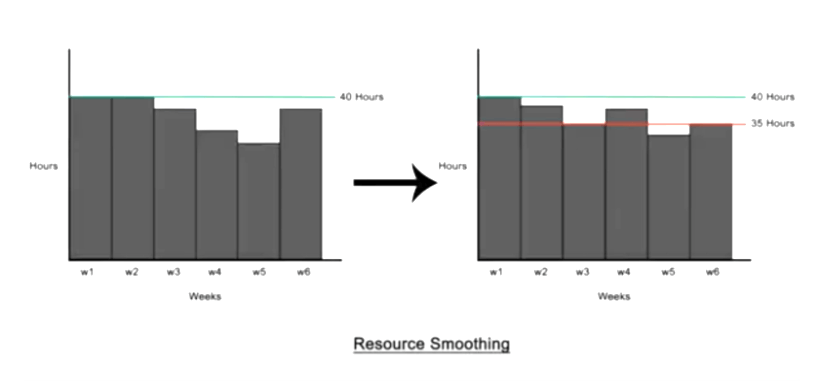
Click the button to start reading
Project Best Practices: How to Use Smoothing in Resource Management
Project planning is a long process. Even after huge milestones are met, things are usually still in a tangle. Getting everything firmly into place requires several more yanks with a fine tooth comb.
Gathering all the requirements and then defining the project’s scope is a significant threshold, for sure. Yet, during the process of allocating resources, it often becomes apparent that things are really out of whack.
Some people may be working several twelve hour days, with huge breaks in between, while others are assigned to two tasks at the same time. Plus, the equipment may not be available when it’s needed.
There’s still a lot to smooth out.
This final stage of teasing things out is known as resource allocation. After extending the project schedule if need be, it’s all about distributing resources in order to suit people’s desires and preferences. The two techniques used in resource allocation are known as resource smoothing and resource leveling.
Are you wondering more about resource smoothing in project management? This post examines resource smoothing within the broader framework of resource management, and compares it to resource leveling.

Resource Management: Process & Strategies
Resource smoothing is a central technique in resource management. Before discussing resource smoothing, then, it’s helpful first to clarify everything included in the term resource, and briefly explain the resource management process.
Resource: A Definition
In project management, resources refer to many things, including people, objects, and money.
The PM Glossary defines it as: “The elements needed for a project to successfully meet its objectives. Examples of resources include equipment, staff, locations, facilities, and money.”
Resources include the equipment needed to complete a project, as well as the materials within the final project. They also include everyone who works to bring a project to completion.
For example, in a construction project, resources include the backhoe used to excavate the property, the concrete used in the foundation, as well as both the contract labor and the salaried employees. It includes the money to pay for it all, as well.
Resource Management: The Process
Resource management is all about when you use resources within a project, and how they’re used. It is a process that begins with planning all the necessary resources, then continues with both scheduling and allocating them. Let’s look at some preliminary steps to developing a resource management plan, in order to identify where project smoothing occurs in the process.

1. Determine the Project’s Scope.
Once all the requirements have been collected by the stakeholders, it’s possible to determine the project’s scope. Using the timeline, the budget, and the requirements, the scope is outlined in a scope document that clarifies the requirements, constraints, exclusions and assumptions.
2. Create a Work Breakdown Structure (WBS).
A work breakdown structure displays all of the work packages required to fulfill the project’s requirements. It is created by decomposing a project’s high level requirements into increasingly smaller tasks. It clarifies all of the project’s required resources.
3. Determine Required Resources.
Using the small tasks at Level 3 and Level 4 of the WBS, it’s possible at this point to determine all the resources required to complete a project, including the supplies, equipment, labor and money.
4. Use Resources Allocation Strategies.
Even though the resources required to complete the project are clear, there are still a lot of things to smooth out.
When tasks and resources are laid out onto a project’s schedule, all sorts of conflicts become apparent. Some people have been over allocated to various tasks. In other instances, equipment and materials won’t be available at the scheduled time.
This is the stage for applying resource allocation strategies.
What is resource allocation? The Project Management Glossary defines it as: “The assigning and scheduling of resources for project-related activities, ideally in the most efficient manner possible. Resource allocation is typically handled by a project manager, though they may be overridden by a program manager if resources are to be shared between multiple projects.”
As previously stated, resource smoothing is one of the two central resource allocation techniques.
With these clarifications, it’s time to discuss resource smoothing.

Resource Smoothing: Definition & Benefits
Resource smoothing is a method for optimizing resources and equally distributing them throughout a project.
The Project Management Glossary defines it as: “A technique that makes use of float when allocating resources so as not to affect total project duration. It is used when project time constraints are important. Resource smoothing does not affect a project’s critical path.”
Resource smoothing does not extend a project’s completion date. After it’s utilized, that is to say, the critical path remains the same. Rather, this allocation technique focuses on non-critical activities, those with float or slack.
Float or slack are basically the same thing. They are a measurement of an activity’s wiggle room. The Project Management Glossary defines each as:
Slack time – The length of time an activity’s early start can be delayed without affecting project duration.
Float – A measure of the schedule flexibility involving a particular task.
For example, say an eight hour project needs to be completed within one week. Its slack, or float, would be four days. Slack and float can also be measured in hours.
Resource smoothing cannot be not delayed any longer than an activity’s total float. Using the previous example, this means the activity cannot be scheduled during the following week without impacting the critical path, and causing delays to other activities.

As displayed by this histogram, smoothing evens out resources within a project without extending the project.
Smoothing isn’t so much about constraints, that is to say, but it’s about desired limits. It’s about making resources sensibly distributed within the constraints of the critical path.
Benefits of Smoothing
Smoothing doesn’t always work. When two activities have hard dependencies, for example, things cannot be shifted around. But when it is possible, smoothing a project provides several clear and tangible benefits.
1. Prevents Burnout
Most people are willing to work 40 hours in a week. At the same time, most people get burnt out from a 12 hour workday. A lopsided work schedule quickly leads to a place of burnout and exhaustion.
Smoothing is about distributing and equalizing work. If all the work for one week is scheduled from Monday to Wednesday, for example, smoothing distributes the work into the final two weekdays as well, in order to create a more rounded schedule.
2. Prevents Overuse of Equipment
Smoothing encourages the moderate use of equipment. When a project has been smoothed and resources equally allocated, it precludes a scenario where equipment gets overused and worn down quickly.
3. Improves Company Culture
Work-life balance is one of the pillars of a healthy workplace culture. Smoothing respects work and life boundaries, and creates an environment where people have time for work and for the rest of their life as well.
As explained, smoothing doesn’t consider a project’s constraints. Rather, it quite literally smooths things out, within the given constraints. It’s like smoothing out a sandbox with a little rake. Nothing goes beyond the walls of the sandbox, but everything within it gets leveled out.
An example of smoothing helps to demonstrate where and how it works within a project.

Example of Resource Smoothing
Let’s look at an example of a kitchen remodel that has three principle installation tasks. The backsplash, the cupboards, and the refrigerator all need to be installed by the end of the week. One person is hired to complete the cabinets, while a second is hired for the second two tasks.
The cupboards take 40 hours to install, while the backsplash and the refrigerator each take 10 hours. The second two tasks, then, each have 30 hours of float.
Originally, the refrigerator and the backslash are scheduled to be completed on Monday and Tuesday, in 10 hours each day. The cupboards are to be installed over the entire week, in equal increments of time.
However, upon closer examination, the resource manager decides to disperse the backsplash and refrigerator installations over the entire week, utilizing the float for each task. Monday and Tuesday are dedicated to the backsplash, with five hours each day, and Wednesday and Thursday are dedicated to the refrigerator, again with five hours each day.
The benefit or objective of smoothing is to find breathing space in a schedule. Shifting activities with float evens out work schedules so that a more equal amount of work is completed on each day of the project. It doesn’t change the critical path, or the overall timeline of the project.

Leveling: The Other Resource Allocation Technique
Sometimes when a project manager takes a closer look at a project’s critical path, it becomes clear that things need to shift around. For example, maybe two tasks scheduled in parallel require the same person to work for eight hours. Clearly, these two tasks need to be scheduled in sequence. If one task is on the critical path, this extends the critical path by eight hours.
This demonstrates a resource allocation technique known as leveling.
Resource leveling is defined as: “A technique that involves amending the project schedule to keep resource use below a set limit. It is used when it is important to impose limits on resource use. Resource leveling can affect a project’s critical path.”
Resource leveling focuses on resources with constraints. Sometimes a resource is only available at a certain time, or in certain amounts. When this scarcity is taken into account, it can impact the project’s timeline and its critical path.
Leveling and smoothing are both integral to the resource management processes, in seeing that all resources in a project are properly scheduled and distributed.

Leveling and Smoothing: Comparison and Contrast
Leveling and smoothing both focus on resource allocation, but each function a little differently. Let’s compare and contrast the two.
Constraints versus Desires
Resource leveling is driven by constraints, while resource smoothing is driven by desires. Another way to say this is that leveling is a must, and smoothing is a should.
Resource leveling means the reallocation of resources when there is no other option. For example, if a task is scheduled for Monday, but the necessary equipment is only available on Tuesday, then the task must be moved to Tuesday.
Resource leveling, rather, caters to preferences. It’s about evening things out so that no one is burdened with a heavy workload, and no work schedules are lopsided.
Leveling Before Smoothing
When firming up a project’s schedule, the process of leveling is applied before smoothing. This determines the final critical path.
Once the path is in place, it’s then possible to find activities with float, and smooth out the resources wherever possible.
Leveling May Increase the Schedule
Leveling affects the critical path and so it usually increases the project’s schedule. Smoothing is only applied to non-critical activities, or those with float. Smoothing maintains all of a project’s time and budget and scope constraints, and moves things around within them.
Conclusion
Now that we’ve gone over the basics of smoothing and resource management, here’s a question: Is the project manager a resource to manage?
That’s a bit of a stumper.
But back to the central point: project smoothing is about meeting desired limits, rather than hard constraints. It’s about addressing a project with moderation and creating a positive work scenario that uses equipment prudently and respects work-life balance.
Do you ever wish you could have a four-day work week? Resource smoothing seeks to meet this kind of desire.
Along with the technique of resource leveling, a project manager uses resource smoothing to get all of the pieces in place to begin a project.
If you’re scheduling resources for a remote project, consider using Teamly. This intuitive project manager software allows you to visually display all of a project’s tasks and timelines for easy scheduling and organization. Visit us and sign up today!
















